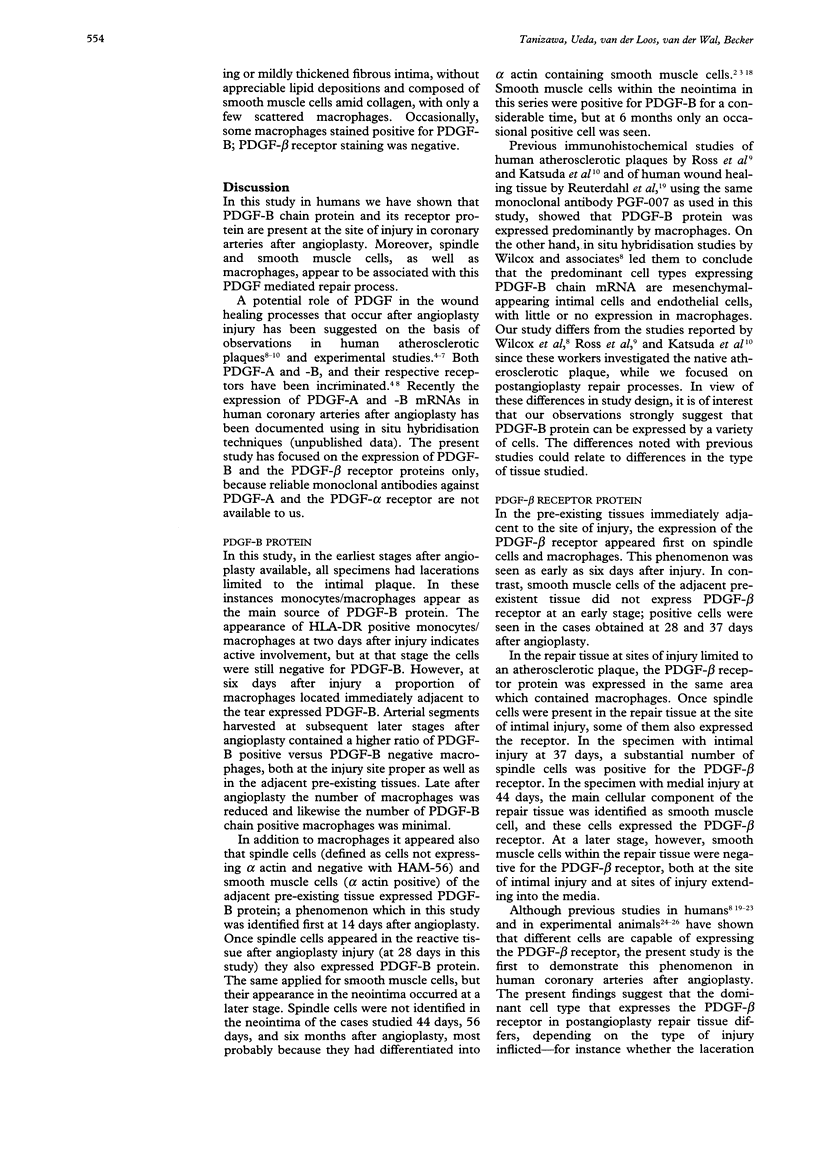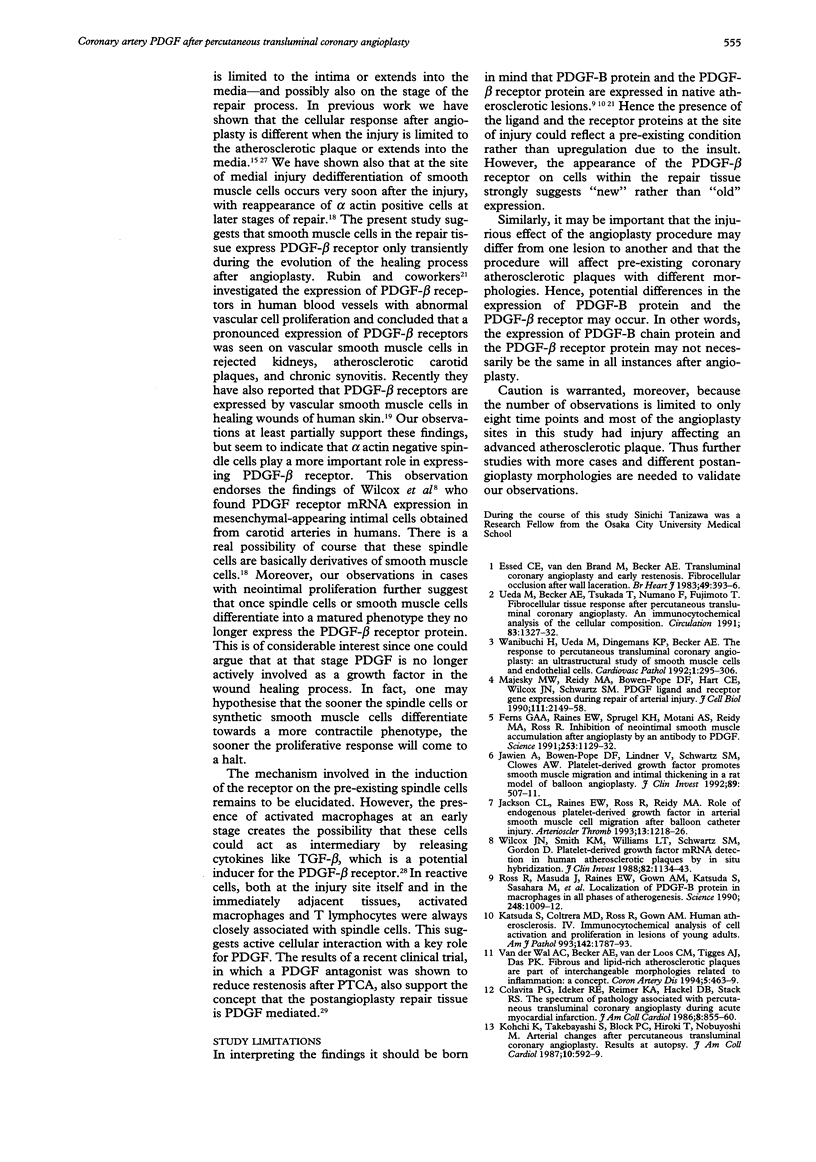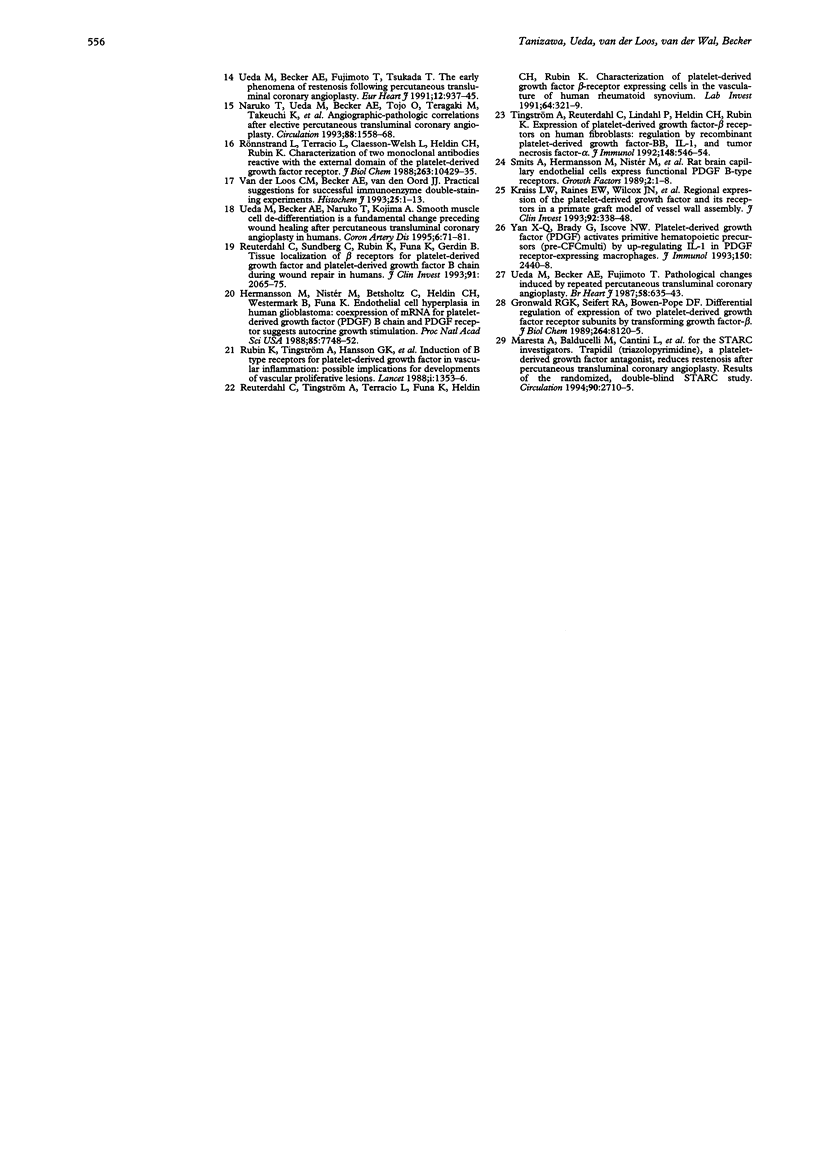Abstract
OBJECTIVE: To evaluate whether expression of platelet derived growth factor B (PDGF-B) protein is associated with expression of its receptor protein in human coronary arteries after angioplasty and to identify cells involved. BACKGROUND: PDGF is considered an important growth factor in the repair process of the vessel wall after angioplasty. In situ hybridisation has revealed expression of PDGF-A and -B chain messenger ribonucleic acid (mRNA) in human coronary arteries at sites of postangioplasty injury. METHODS: Target and non-target sites of eight coronary arteries were studied immunohistochemically for PDGF-B and PDGF-beta receptor proteins in relation to macrophages, T lymphocytes, smooth muscle cells, and HLA-DR positive cells. RESULTS: The PDGF-B and PDGF-beta receptor proteins were expressed in areas with distinct repair, containing alpha actin negative spindle cells, macrophages and, at later stages, alpha actin positive smooth muscle cells as well. When the neointima was composed mainly of alpha actin smooth muscle cells, PDGF-B expression was rare and PDGF-beta receptor expression was negative. CONCLUSIONS: There is expression of PDGF-B and PDGF-beta receptor proteins at sites of postangioplasty repair in human coronary arteries. The associated cells are mainly macrophages and alpha actin negative spindle cells; the latter may be dedifferentiated smooth muscle cells. A link between PDGF expression and the postangioplasty time interval suggests a relation with cell differentiation as part of the maturation of the repair tissue. Mutual expression of both the growth factor and its receptor protein strongly suggests that in humans a PDGF mediated repair process occurs, with involvement of smooth muscle cells and macrophages.
Full text
PDF







Images in this article
Selected References
These references are in PubMed. This may not be the complete list of references from this article.
- Colavita P. G., Ideker R. E., Reimer K. A., Hackel D. B., Stack R. S. The spectrum of pathology associated with percutaneous transluminal coronary angioplasty during acute myocardial infarction. J Am Coll Cardiol. 1986 Oct;8(4):855–860. doi: 10.1016/s0735-1097(86)80427-2. [DOI] [PubMed] [Google Scholar]
- Essed C. E., Van den Brand M., Becker A. E. Transluminal coronary angioplasty and early restenosis. Fibrocellular occlusion after wall laceration. Br Heart J. 1983 Apr;49(4):393–396. doi: 10.1136/hrt.49.4.393. [DOI] [PMC free article] [PubMed] [Google Scholar]
- Ferns G. A., Raines E. W., Sprugel K. H., Motani A. S., Reidy M. A., Ross R. Inhibition of neointimal smooth muscle accumulation after angioplasty by an antibody to PDGF. Science. 1991 Sep 6;253(5024):1129–1132. doi: 10.1126/science.1653454. [DOI] [PubMed] [Google Scholar]
- Gronwald R. G., Seifert R. A., Bowen-Pope D. F. Differential regulation of expression of two platelet-derived growth factor receptor subunits by transforming growth factor-beta. J Biol Chem. 1989 May 15;264(14):8120–8125. [PubMed] [Google Scholar]
- Hermansson M., Nistér M., Betsholtz C., Heldin C. H., Westermark B., Funa K. Endothelial cell hyperplasia in human glioblastoma: coexpression of mRNA for platelet-derived growth factor (PDGF) B chain and PDGF receptor suggests autocrine growth stimulation. Proc Natl Acad Sci U S A. 1988 Oct;85(20):7748–7752. doi: 10.1073/pnas.85.20.7748. [DOI] [PMC free article] [PubMed] [Google Scholar]
- Jackson C. L., Raines E. W., Ross R., Reidy M. A. Role of endogenous platelet-derived growth factor in arterial smooth muscle cell migration after balloon catheter injury. Arterioscler Thromb. 1993 Aug;13(8):1218–1226. doi: 10.1161/01.atv.13.8.1218. [DOI] [PubMed] [Google Scholar]
- Jawien A., Bowen-Pope D. F., Lindner V., Schwartz S. M., Clowes A. W. Platelet-derived growth factor promotes smooth muscle migration and intimal thickening in a rat model of balloon angioplasty. J Clin Invest. 1992 Feb;89(2):507–511. doi: 10.1172/JCI115613. [DOI] [PMC free article] [PubMed] [Google Scholar]
- Kohchi K., Takebayashi S., Block P. C., Hiroki T., Nobuyoshi M. Arterial changes after percutaneous transluminal coronary angioplasty: results at autopsy. J Am Coll Cardiol. 1987 Sep;10(3):592–599. doi: 10.1016/s0735-1097(87)80202-4. [DOI] [PubMed] [Google Scholar]
- Kraiss L. W., Raines E. W., Wilcox J. N., Seifert R. A., Barrett T. B., Kirkman T. R., Hart C. E., Bowen-Pope D. F., Ross R., Clowes A. W. Regional expression of the platelet-derived growth factor and its receptors in a primate graft model of vessel wall assembly. J Clin Invest. 1993 Jul;92(1):338–348. doi: 10.1172/JCI116572. [DOI] [PMC free article] [PubMed] [Google Scholar]
- Majesky M. W., Reidy M. A., Bowen-Pope D. F., Hart C. E., Wilcox J. N., Schwartz S. M. PDGF ligand and receptor gene expression during repair of arterial injury. J Cell Biol. 1990 Nov;111(5 Pt 1):2149–2158. doi: 10.1083/jcb.111.5.2149. [DOI] [PMC free article] [PubMed] [Google Scholar]
- Maresta A., Balducelli M., Cantini L., Casari A., Chioin R., Fabbri M., Fontanelli A., Monici Preti P. A., Repetto S., De Servi S. Trapidil (triazolopyrimidine), a platelet-derived growth factor antagonist, reduces restenosis after percutaneous transluminal coronary angioplasty. Results of the randomized, double-blind STARC study. Studio Trapidil versus Aspirin nella Restenosi Coronarica. Circulation. 1994 Dec;90(6):2710–2715. doi: 10.1161/01.cir.90.6.2710. [DOI] [PubMed] [Google Scholar]
- Naruko T., Ueda M., Becker A. E., Tojo O., Teragaki M., Takeuchi K., Takeda T. Angiographic-pathologic correlations after elective percutaneous transluminal coronary angioplasty. Circulation. 1993 Oct;88(4 Pt 1):1558–1568. doi: 10.1161/01.cir.88.4.1558. [DOI] [PubMed] [Google Scholar]
- Reuterdahl C., Sundberg C., Rubin K., Funa K., Gerdin B. Tissue localization of beta receptors for platelet-derived growth factor and platelet-derived growth factor B chain during wound repair in humans. J Clin Invest. 1993 May;91(5):2065–2075. doi: 10.1172/JCI116429. [DOI] [PMC free article] [PubMed] [Google Scholar]
- Reuterdahl C., Tingström A., Terracio L., Funa K., Heldin C. H., Rubin K. Characterization of platelet-derived growth factor beta-receptor expressing cells in the vasculature of human rheumatoid synovium. Lab Invest. 1991 Mar;64(3):321–329. [PubMed] [Google Scholar]
- Ross R., Masuda J., Raines E. W., Gown A. M., Katsuda S., Sasahara M., Malden L. T., Masuko H., Sato H. Localization of PDGF-B protein in macrophages in all phases of atherogenesis. Science. 1990 May 25;248(4958):1009–1012. doi: 10.1126/science.2343305. [DOI] [PubMed] [Google Scholar]
- Rubin K., Tingström A., Hansson G. K., Larsson E., Rönnstrand L., Klareskog L., Claesson-Welsh L., Heldin C. H., Fellström B., Terracio L. Induction of B-type receptors for platelet-derived growth factor in vascular inflammation: possible implications for development of vascular proliferative lesions. Lancet. 1988 Jun 18;1(8599):1353–1356. doi: 10.1016/s0140-6736(88)92177-0. [DOI] [PubMed] [Google Scholar]
- Rönnstrand L., Terracio L., Claesson-Welsh L., Heldin C. H., Rubin K. Characterization of two monoclonal antibodies reactive with the external domain of the platelet-derived growth factor receptor. J Biol Chem. 1988 Jul 25;263(21):10429–10435. [PubMed] [Google Scholar]
- Smits A., Hermansson M., Nistér M., Karnushina I., Heldin C. H., Westermark B., Funa K. Rat brain capillary endothelial cells express functional PDGF B-type receptors. Growth Factors. 1989;2(1):1–8. doi: 10.3109/08977198909069076. [DOI] [PubMed] [Google Scholar]
- Tingström A., Reuterdahl C., Lindahl P., Heldin C. H., Rubin K. Expression of platelet-derived growth factor-beta receptors on human fibroblasts. Regulation by recombinant platelet-derived growth factor-BB, IL-1, and tumor necrosis factor-alpha. J Immunol. 1992 Jan 15;148(2):546–554. [PubMed] [Google Scholar]
- Ueda M., Becker A. E., Fujimoto T. Pathological changes induced by repeated percutaneous transluminal coronary angioplasty. Br Heart J. 1987 Dec;58(6):635–643. doi: 10.1136/hrt.58.6.635. [DOI] [PMC free article] [PubMed] [Google Scholar]
- Ueda M., Becker A. E., Naruko T., Kojima A. Smooth muscle cell de-differentiation is a fundamental change preceding wound healing after percutaneous transluminal coronary angioplasty in humans. Coron Artery Dis. 1995 Jan;6(1):71–81. doi: 10.1097/00019501-199501000-00011. [DOI] [PubMed] [Google Scholar]
- Ueda M., Becker A. E., Tsukada T., Numano F., Fujimoto T. Fibrocellular tissue response after percutaneous transluminal coronary angioplasty. An immunocytochemical analysis of the cellular composition. Circulation. 1991 Apr;83(4):1327–1332. doi: 10.1161/01.cir.83.4.1327. [DOI] [PubMed] [Google Scholar]
- Wilcox J. N., Smith K. M., Williams L. T., Schwartz S. M., Gordon D. Platelet-derived growth factor mRNA detection in human atherosclerotic plaques by in situ hybridization. J Clin Invest. 1988 Sep;82(3):1134–1143. doi: 10.1172/JCI113671. [DOI] [PMC free article] [PubMed] [Google Scholar]
- Yan X. Q., Brady G., Iscove N. N. Platelet-derived growth factor (PDGF) activates primitive hematopoietic precursors (pre-CFCmulti) by up-regulating IL-1 in PDGF receptor-expressing macrophages. J Immunol. 1993 Mar 15;150(6):2440–2448. [PubMed] [Google Scholar]
- van der Loos C. M., Becker A. E., van den Oord J. J. Practical suggestions for successful immunoenzyme double-staining experiments. Histochem J. 1993 Jan;25(1):1–13. doi: 10.1007/BF00161039. [DOI] [PubMed] [Google Scholar]
- van der Wal A. C., Becker A. E., van der Loos C. M., Tigges A. J., Das P. K. Fibrous and lipid-rich atherosclerotic plaques are part of interchangeable morphologies related to inflammation: a concept. Coron Artery Dis. 1994 Jun;5(6):463–469. [PubMed] [Google Scholar]






